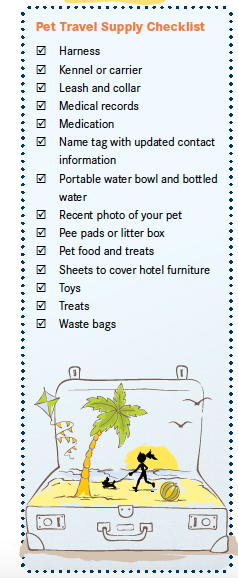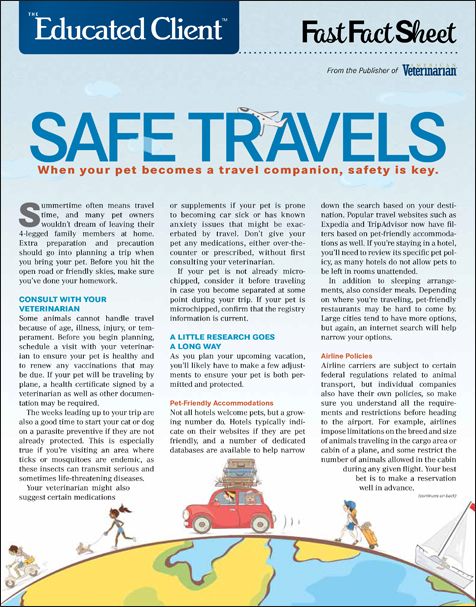The Educated Client: Safe Travels
When your pet becomes a travel companion, safety is key.
Summertime often means travel time, and many pet owners wouldn’t dream of leaving their 4-legged family members at home. Extra preparation and precaution should go into planning a trip when you bring your pet. Before you hit the open road or friendly skies, make sure you’ve done your homework.
Consult With Your Veterinarian
Some animals cannot handle travel because of age, illness, injury, or temperament. Before you begin planning, schedule a visit with your veterinarian to ensure your pet is healthy and to renew any vaccinations that may be due. If your pet will be traveling by plane, a health certificate signed by a veterinarian as well as other documentation may be required.
The weeks leading up to your trip are also a good time to start your cat or dog on a parasite preventive if they are not already protected. This is especially true if you’re visiting an area where ticks or mosquitoes are endemic, as these insects can transmit serious and sometimes life-threatening diseases.
RELATED:
- Understanding and Preventing Heartworm Disease
- Understanding Pet Obesity
Your veterinarian might also suggest certain medications or supplements if your pet is prone to becoming car sick or has known anxiety issues that might be exacerbated by travel. Don’t give your pet any medications, either over-the- counter or prescribed, without first consulting your veterinarian.
If your pet is not already microchipped, consider it before traveling in case you become separated at some point during your trip. If your pet is microchipped, confirm that the registry information is current.
A Little Research Goes a Long Way
As you plan your upcoming vacation, you’ll likely have to make a few adjustments to ensure your pet is both permitted and protected.
Pet-Friendly Accommodations
Not all hotels welcome pets, but a growing number do. Hotels typically indicate on their websites if they are pet friendly, and a number of dedicated databases are available to help narrow down the search based on your destination. Popular travel websites such as Expedia and TripAdvisor now have filters based on pet-friendly accommodations as well. If you’re staying in a hotel, you’ll need to review its specific pet policy, as many hotels do not allow pets to be left in rooms unattended.
In addition to sleeping arrangements, also consider meals. Depending on where you’re traveling, pet-friendly restaurants may be hard to come by. Large cities tend to have more options, but again, an internet search will help narrow your options.
Airline Policies
Airline carriers are subject to certain federal regulations related to animal transport, but individual companies also have their own policies, so make sure you understand all the requirements and restrictions before heading to the airport. For example, airlines impose limitations on the breed and size of animals traveling in the cargo area or cabin of a plane, and some restrict the number of animals allowed in the cabin during any given flight. Your best bet is to make a reservation well in advance.
International Travel
Many countries have strict regulations regarding international pet travel. There are no blanket requirements, so you’ll need to research your destination’s laws. Most will require that your pet be vaccinated within a specific time period prior to entering the country and that your veterinarian completes a health certificate stating the pet has no infectious diseases. Some countries accept a generic certificate and others have their own. Certain countries, such as Australia and China, also require pets to be quarantined upon arrival.
Safety Is Top Priority
As soon as you decide that you’ll be traveling with your pet, begin creating a checklist of everything you need to bring and/or purchase. This includes a carrier that your pet can fit in properly with the ability to stand up and turn around. If traveling by car, you may want to use a pet harness, too.
For added security, attach a second tag to your pet’s collar that includes the contact information of where you will be staying during the trip. Also, be sure to bring a recent photo of your pet in case you become separated. Additionally, pack your pet’s medical records and have a nearby veterinarian’s contact information in case of an emergency.
Prepare Your Pet

If your pet isn’t used to traveling, acquaint him or her with key aspects of the experience as early as you can. If they will be spending extended time in a carrier, make sure they are familiar with the exact one you’ll be using. Confining an animal to an unfamiliar kennel can cause unnecessary stress, and your pet may be physically harmed trying to escape.
Start by placing the carrier in an open area of the house with the door open. Eventually, your curious pet should start to venture in and out at will. At this point, you can start to shut the door for a few minutes at a time. Always provide treats both in the carrier and as a reward for each successful test run. For added tranquility, spray a blanket with synthetic pheromones 10 minutes before the pet enters.
Also familiarize your pet with the vehicle you’ll be driving. Just as with the carrier, start slow. Spend time in the car with your pet and generously dole out treats and head scratches. Gradually increase the amount of time your pet spends in the car; sit in the driveway with the ignition on and go for short drives to somewhere fun so that your pet associates the car with a positive experience.
Bon Voyage!
Feed your pet several hours before heading to the airport or taking to the road, and provide time for a bathroom break. Pack adequate food and bottled water to last the duration of your trip. Federal flying regulations require that animals have food at least every 24 hours and water at least every 12 hours. Written instructions for food and water must accompany all animals flying as cargo regardless of the scheduled time in transit.
When traveling by car, be sure your pet is secure, either in a carrier or using a harness. Pets wandering freely in a vehicle can pose a distraction, and they are more likely to be injured in the event of an accident or sudden stop. According to the American Automobile Association, about 30,000 accidents are caused each year by an unrestrained dog in the front seat. As much as your dog might enjoy sticking his head out the window, this presents another safety risk and should be avoided.
In addition, at no point should a pet be left unattended in a car. Even with the windows cracked, the temperature inside a car increases drastically within a short period of time.
Stop every 2 to 3 hours to let your dog stretch his legs and relieve himself. Cats should also have access to a litter tray during the commute.
Once you arrive at your destination, give your pet a tour so they know where the food, water, and bedding are; for cats, a litter box, too. It’s also a good idea to cover any furniture that you think your pet might hop up on. An old sheet or towel will suffice.
Most importantly, have a great time with your pet!
Click here for all American Veterinarian® client education materials.
